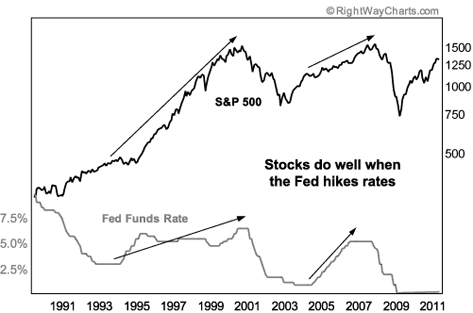| Home | About Us | Resources | Archive | Free Reports | Market Window |
Why Stocks Will Rally When the Fed Stops Printing MoneyBy
Tuesday, May 10, 2011
The big fear in the market is this: What happens when the Fed stops printing money and starts raising interest rates? Won't stocks fall?
You'll be surprised...
I crunched the numbers and found, in recent times, stocks do surprisingly well when the Fed starts to hike interest rates.
Here's the best way I can explain it: When the Fed starts to hike interest rates, it's signaling to the rest of the world the danger has passed. When stock market investors believe the danger has passed, they push prices up.
You can see it in the chart below...
 You'll notice the Fed hiked interest rates during the bull market of the mid-1990s. Over the next five years, stocks went on to rally to incredible new highs... and then crashed. The Fed also increased rates starting in 2004. Stocks continued to rally for years after.
In both instances, the Fed hiked rates for years before stocks felt the pinch of the increased rates. Stocks only start to fall, buckling the economy, after the Fed has hiked interest rates too high and held them there too long.
Importantly, we may have a long wait until the Fed starts to hike rates...
As I've said many times, the Fed will likely keep rates extremely low for longer than anyone can imagine. This will allow the price of stocks and commodities to soar higher than anyone can imagine.
Stocks can certainly do well for years when the Fed is raising interest rates. But their performance is not actually caused by increased interest rates.
The Fed only starts to raise interest rates once the economy appears to be on solid footing. So stocks rise because the economy is doing well, not because interest rates are rising.
Yes, the end of the Fed's "QE2" (the second round of quantitative easing) is nearing an end... And yes, the Fed will raise interest rates from their ridiculously low levels at some point.
But no, it's not the end of the world for stock investors...
If the last few times are any indication, the end of the Fed's "easy money" could mean the continuation of this bull market in stocks... one that could last for years.
Good investing,
Steve
Further Reading:
Longtime DailyWealth readers know Steve looks for three things in an investment: cheap, hated, and in an uptrend. Now, he's found a sector that satisfies all three requirements. He says if you catch one of these booms, you may never have to work again.
Steve recently told DailyWealth readers about a currency strategy that boasts similar returns to the stock market... but is virtually risk-free. If you're looking outside the box for investment ideas, you'll want to read the full story here: Safe, Big Returns in a Simple Currency Strategy.
Market NotesTHE COMMODITY UPTREND IS PUNCHED IN THE GUT Today, we're talking about one of the biggest market stories you're not hearing about right now – Copper just "broke the box."
Longtime DailyWealth readers know we regularly monitor the copper price. Copper is a vital ingredient in automobiles, plumbing, electrical infrastructure, electronics, and commercial construction. This makes it one of the most important raw materials in the world.
Like most assets, copper was clobbered in the 2008/2009 credit crisis... then enjoyed a stupendous "reflation" rally that sent the metal to $4.60 per pound this February. Copper spent the next three months drifting in a sideways pattern some traders call a "box." As you can see from the chart below, copper just punched through the bottom of the box...
It's too early to pronounce the end of the copper bull market. This could be a temporary setback. But at the very least, it's a "punch in the gut" for the commodities uptrend... one that will take months to recover from.
|
In The Daily Crux
Recent Articles
|

